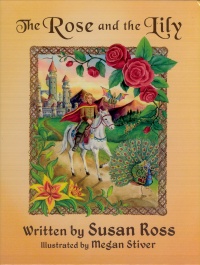| ________________
CM . . . . Volume XVII Number 38 . . . . June 3, 2011
excerpt:
In this seemingly innocuous fairy tale story, King William wants to rid himself of his impetuous daughter, Princess Rose, by offering her in marriage to an available suitor. Utterly rejecting all suitors except one, the beautiful Princess Rose greedily demands that Prince Sterling find her the perfect hairpin in exchange for her hand in marriage. After three gallant attempts at finding or making the “perfect” hairpin, Prince Sterling learns (as stated on the book’s back cover) that “beauty is in the eye of the beholder” and “beauty is only skin deep.” Consequently, Prince Sterling falls in love with the plain, but genteel, common woman Lily, instead of the attractive, yet snide, Princess Rose.
For a book that is aiming to entertain an audience range from Junior Kindergarten to Lower Intermediate (Gr. 4) (as stated in the publisher’s recommendation), I find that the vocabulary is too complex for the target age and reading levels. Words such as preening, petty, and pompous, are used in the text for alliterative purposes, but, in my opinion, are too unfamiliar for child readers to know on their own. In addition, regardless of the anti-superficial lessons learned by Prince Sterling, paradoxically, the text sincerely includes the clichéd lines, such as: “Diamonds are a girl’s best friend” (p. 16), and “Baby needs a new Teddy Bear” (p. 22) (referring to a rainbow-coloured dragon named Baby). These tacky sayings cropped up sporadically and added an unwanted sickly-sweet taste to the text. It is admirable that Susan Ross attempts to discuss issues of self-esteem; however, the way this message is delivered makes the book feel disjointed. While the story’s plotline promotes the proverbs “beauty is in the eye of the beholder,” and “beauty is only skin deep,” at the end of the book, there is a ludicrous poem, “Just for You” (partially quoted in the excerpt), which gives the pretence that the book is about developing self-esteem in children. I ask this: can Princess Rose also chant the line “I’m so proud to be me” (p. 30)? This overtly didactic, patronizingly simplified, and candy-coated poem feels incoherently tacked on to the end of this book. Another illogical addition to this book is the crown craft instructions at the back. Indeed, there are royal characters in the story, but would it not make more sense to make a hairpin craft, considering the fact that the “perfect hairpin” is the central and desired object in the story? Finally, and regrettably, the computer-enhanced watercolour illustrations do not add any redeeming qualities to this book. At a time when simple, minimalistic, and comic-styled anime is frequently used in other contemporary illustrated books, I found these illustrations to be surprisingly old-fashioned, and out of style, especially for such a young illustrator. Although, Megan Stiver’s illustrations did visually demonstrate the subtle outward changes in beauty for both Princess Rose and Lily, the former getting uglier, and the latter getting prettier, overall, the illustrations are excessively-detailed and, frankly, uninteresting. On the whole, The Rose and the Lily felt disjointed in both intention and execution. Unfortunately, as much as I would like to endorse small self-published Canadian books, I cannot with a clear conscience recommend this book for purchase. Not Recommended. Dorothea Wilson-Scorgie is currently a Teacher-On-Call in Victoria, BC, while also pursuing her MA degree in Children’s Literature at the University of British Columbia in Vancouver.
To comment
on this title or this review, send mail to cm@umanitoba.ca.
Copyright © the Manitoba Library Association. Reproduction for personal
use is permitted only if this copyright notice is maintained. Any
other reproduction is prohibited without permission.
NEXT REVIEW |
TABLE OF CONTENTS FOR THIS ISSUE
- June 3, 2011.
AUTHORS |
TITLES |
MEDIA REVIEWS |
PROFILES |
BACK ISSUES |
SEARCH |
CMARCHIVE |
HOME |

 Although Susan Ross’ storybook, The Rose and the Lily, was 20 years in the making, regrettably, it just seems to fail to miss the mark on many counts. The familiar storyline of a father wanting to marry off his daughter is predictable, unremarkable, and outdated regarding the interests of a modern child audience. Also, it is clear from the moment that the character of Lily is introduced that this will be a rags-to-riches reversal at the end of the story, thus making the long text feel longer as the impending relationship of Prince Sterling and Lily is an obvious foregone conclusion from page 12.
Although Susan Ross’ storybook, The Rose and the Lily, was 20 years in the making, regrettably, it just seems to fail to miss the mark on many counts. The familiar storyline of a father wanting to marry off his daughter is predictable, unremarkable, and outdated regarding the interests of a modern child audience. Also, it is clear from the moment that the character of Lily is introduced that this will be a rags-to-riches reversal at the end of the story, thus making the long text feel longer as the impending relationship of Prince Sterling and Lily is an obvious foregone conclusion from page 12.